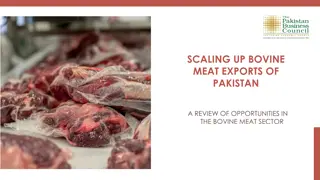Understanding Meat Grading and Quality Certification
Explore the process of meat grading and certification, including the establishment of USDA standards, mandatory inspection for wholesomeness, voluntary grading for quality, and the determination of quality grades based on factors like tenderness, juiciness, flavor, and marbling. Learn how age and marbling impact the quality grade, and how graders determine the age of animals through ossification inspection.
Uploaded on Sep 17, 2024 | 0 Views
Download Presentation

Please find below an Image/Link to download the presentation.
The content on the website is provided AS IS for your information and personal use only. It may not be sold, licensed, or shared on other websites without obtaining consent from the author. Download presentation by click this link. If you encounter any issues during the download, it is possible that the publisher has removed the file from their server.
E N D
Presentation Transcript
Bell Work Bell Work What was the first food product What was the first food product permitted by law to have artificial permitted by law to have artificial coloring? coloring? Butter Butter
Describing Meat Describing Meat Grading Grading
Grading 101 Grading 101 After the carcasses are cooled, they are After the carcasses are cooled, they are graded according to USDA standards. graded according to USDA standards. Federal Meat Grading was established Federal Meat Grading was established in 1925 by the Agricultural in 1925 by the Agricultural Marketing Service (AMS) of USDA. Marketing Service (AMS) of USDA.
Certification Certification Inspection for wholesomeness is Inspection for wholesomeness is mandatory and is paid for out of tax mandatory and is paid for out of tax dollars. Grading for quality is dollars. Grading for quality is voluntary. voluntary. The meat grade certifies the class, The meat grade certifies the class, quality, and condition of the quality, and condition of the agricultural product examined to agricultural product examined to conform with uniform standards. conform with uniform standards.
Grading Grading There are two groups of Grades: There are two groups of Grades: Quality & Yield. Quality & Yield. Quality Grades Quality Grades Prediction for tenderness, juiciness, Prediction for tenderness, juiciness, and flavor. and flavor. Based on the amount of marbling Based on the amount of marbling (flecks of fat within the lean), color, (flecks of fat within the lean), color, and maturity. and maturity.
Quality Grade Determination Quality Grade Determination Grades are determined by the Grades are determined by the age of the animal at slaughter and the amount animal at slaughter and the amount marbling. Age is determined by the Age is determined by the maturity of the the cartilage and and bones in the carcass. Animals older than 42 months cannot Animals older than 42 months cannot receive the highest 2 grades. receive the highest 2 grades. of the of in the carcass.
Determining Age Determining Age Graders inspect the rib cage and Graders inspect the rib cage and vertebrae for the degree of bone and vertebrae for the degree of bone and cartilage hardening cartilage hardening Ossification As the animal ages, vertebrae in As the animal ages, vertebrae in the lower end of backbone tend to the lower end of backbone tend to fuse or grow together. fuse or grow together.
Yield Grades Yield Grades Yield Grades Yield Grades Range from "1" to "5" and indicate Range from "1" to "5" and indicate the amount of usable meat from a the amount of usable meat from a carcass. carcass. Yield grade 1 is the highest grade Yield grade 1 is the highest grade and denotes the greatest ratio of and denotes the greatest ratio of lean to fat; yield grade 5 is the lean to fat; yield grade 5 is the lowest yield ratio. lowest yield ratio.
Yield Grade Determination Yield Grade Determination The yield grade is determined by a The yield grade is determined by a formula used by the grader. formula used by the grader. 1: Clean/muscular 1: Clean/muscular Veal Veal- - 5 Grades 5 Grades Lamb Lamb- - 5 Grades 5 Grades Pork Pork- - Not Graded Not Graded Poultry Poultry- - A, B, C Grade A: Highest Quality 5: Very fat/ Light Muscle Grade A: Highest Quality 5: Very fat/ Light Muscle A, B, C
Beef Beef There are There are eight quality grades for quality grades for beef: prime, choice, select, standard, beef: prime, choice, select, standard, commercial, utility, cutter, and commercial, utility, cutter, and canner. canner. BEEF BEEF ITS ITS WHATS WHATS FOR FOR DINNER DINNER
Marbling Marbling The fat, known as marbling, shows The fat, known as marbling, shows up as specks of white across the rib up as specks of white across the rib eye. The more specks of fat that are eye. The more specks of fat that are visible, the visible, the higher the grade the grade
Piece it Together Piece it Together Prime (BEST) Prime (BEST) Muscle: Muscle: Fat: Fat: Fat is what gives the meat flavor Fat is what gives the meat flavor and and juiciness juiciness
F F- -A A- -C C- -T T- -S S Fat is expensive to put on animals, so Fat is expensive to put on animals, so the leaner grades are less expensive. the leaner grades are less expensive. Those that feed animals to grade Those that feed animals to grade prime usually cater to the restaurant prime usually cater to the restaurant trade. trade. Most feedlot owners want their Most feedlot owners want their animals to grade a low choice at animals to grade a low choice at slaughter. slaughter.
F F- -A A- -C C- -T T- -S S Most beef bought in the grocery store Most beef bought in the grocery store is choice grade. is choice grade. A few market chains are selling the A few market chains are selling the leaner select grade as a low fat meat leaner select grade as a low fat meat























